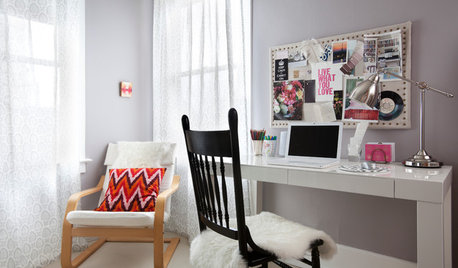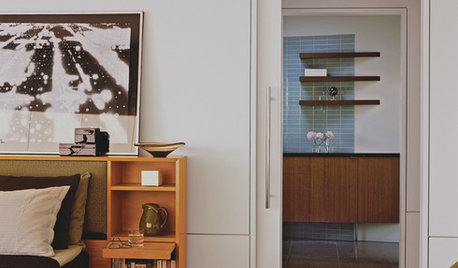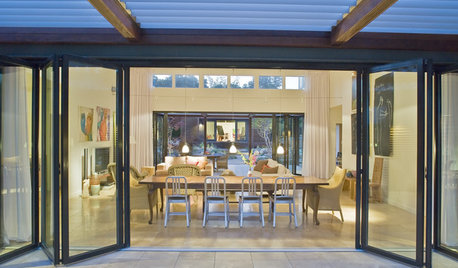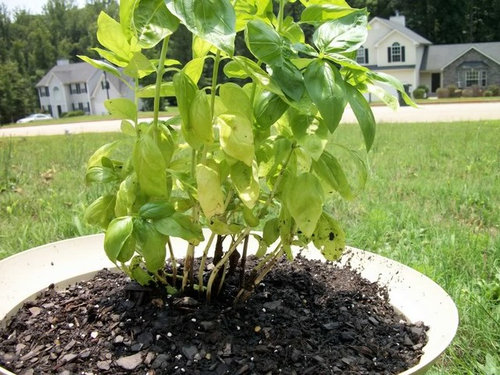Confused about basil
I know it's late but I decided to give basil a try this year. I got two Better Homes and Gardens "Italian large-leaf basil" plants for a dollar so I figured I had nothing to lose. Each "plant" actually looks like a bunch of little stalks which I didn't really think much about until I saw a thread on here where someone posted a similar pic and someone said she had too many plants in one container. Was I somehow supposed to separate these individual little stalks? How in the world? That rootball was TIGHT. There's no way these were coming apart.
Also, I've read that you should let the soil go completely dry (not to the point of wilting) between waterings and that the basil will do better if it's a little stressed. I've also read that you should water it regularly and keep it consistently moist but not wet. Am I missing something?
Also, I've read that basil likes heat and won't do well inside if you keep your AC below 75 and that the plants can get big and bushy. But everyone of those "windowsill" herb garden kits I've ever seen includes basil and those are intended to be grown inside in tiny pots.
So I'm just thoroughly confused. Can anyone help?
Comments (24)
pagirlmint
12 years agolast modified: 9 years agoYeah that is too many plants in one small area. See the slightly yellow leaves? That's because they are over crowded.
I dunno if this is how your "supposed" to separate it, but this is how I do it & it works for me: Get the root ball out of the soil & gently shake as much dirt as possible off of it. Then use a sprayer (the kind on your kitchen sink) to spray room temp water on it & get as much dirt off that way as you can. Get a bucket of water to keep rewetting the roots, take your time & pick threw as much of the root ball as you can to separate it. (Get desperate after 1/2hr & break a few roots, be amazed when plant still grows lol)
I bought a 6" pot from WalMart with over 15 plants (I felt bad for it) all about 8ins+, took me forever to get them apart - never again.Water: Mine have not dried out all summer (it's been hot & rainy) & they are growing like crazy. I don't like to let things get bone dry. But they might grow better stressed, I dunno.
Inside: I've found that anything labeled "Kit" is a joke & the instructions are more worried about it sounding A) Easy & B) Convenient than actually telling you how to grow them. You CAN grow basil inside, but you will have a sub-par plant because of it.
Related Professionals
Garden City Landscape Architects & Landscape Designers · Suffern Landscape Architects & Landscape Designers · Garden City Landscape Architects & Landscape Designers · Canton Landscape Contractors · Avocado Heights Landscape Contractors · Fruit Heights Landscape Contractors · Lemont Landscape Contractors · Pahrump Landscape Contractors · San Pedro Landscape Contractors · Suitland Landscape Contractors · Wanaque Landscape Contractors · White Bear Lake Landscape Contractors · Orlando Roofing & Gutters · Miami Beach Roofing & Gutters · Black Forest Roofing & GuttersDaisyduckworth
12 years agolast modified: 9 years agoEach of those little 'stalks' is an individual basil plant, and yes, you are expected to separate them, keeping the healthiest ones and discarding the runts, if any. It's not such an onerous task, and you can still do it - it's not too late, judging by the size of your seedlings.
Dig up the whole 'clump' carefully, then lay it down onto a flat surface (perhaps using newspaper to 'catch the dirt' and help with the clean-up process later. Then gently open up the pile of dirt vertically (root to tip), exposing the entire seedling.
Have ready some larger pots filled with potting mix, or a garden bed with a small trench. (a)Dibble a whole into the soil in the pots with your finger or a pencil-sized stick, deep enough to accommodate all those roots without squashing them too much, insert a seedling, then gently tamp the soil around the plant with your finger-tips, making sure not to bury the seedling any deeper than it was already (ie just up to the 'dirty mark' on the stem' and no further).
OR (b) lay each seedling on its side with the roots pointing down into your prepared baby trench, at least 40cm apart, then either by hand or with a rake, refill the trench from the opposite side to the seedlings. As you do this, you will notice that the seedlings will be drawn into a vertical position. Tamp in gently to ensure that they do stand up like soldiers. For either pot or garden, water in gently.
Basil is NOT a plant intended for window-sills. In fact, I know of NO plant suited for window-sills, though it might be a useful spot for getting plants started. It's just a temporary place for them. In an ideal climate (think Mediterranean), basil plants can get to well over a metre tall, and just as wide. Hardly the plant for a small pot or a window-sill, methinks. All plants will be much happier outside than inside - basil in particular likes as much real sunshine as it can get, and the hotter it is, the better the flavour. Also, when outside, plants can spread their roots more easily (meaning less hands-on maintenance for you), and also have access to the protection of 'good' bugs to get rid of 'bad' bugs.
Of course, as with baby humans, baby plants need a little help while they're growing - protection from wind or extreme sun/heat. That can easily be achieved by planting the babies amongst taller plants. An excellent companion for basil is tomato plants.
You mention that the rootball was tight. That is NOT a good sign - it means that the seedlings were potbound. However, all is not lost. You can use a knife to separate out the seedlings. Yes, seriously, while it sounds ruthless, a nice strong kitchen knife will do the job (or, if you lay the rootball on its side on the ground, a jab with a spade will do it too!). Then you just gently persuade the seedlings to come out with your fingers, untangling the roots as you go. It won't hurt to cut the bottom off the rootball, perhaps 2cm or so. That will help with the untangling. If the seedlings are so terribly tangled, you can always hose all the dirt off the roots (or soak off the dirt in a bucket of water), exposing the roots and helping you to separate them. You will inevitably lose a few seedlings in the transplant process, but then you will still have quite a lot of plants in the end.
HINT: When transplanting a plant, make sure to make the new hole roughly twice as deep and twice as wide as the existing root ball or individual seedling. This hole will be filled in around the roots when backfilling, but because it's relatively loose under the surface, it enables the tender baby roots to spread out easily to get a firm footing and to enable the plant to get nutrients and water from a greater area. (Think of baby roots trying to break through a solid wall, otherwise).
Because it's an annual, basil can grow quite quickly, but if your warm season is short, you can extend it by erecting a clear plastic cloche or tent over your basil plants - like a mini-hot-house. Make it large enough to that no part of the plant comes into contact with the plastic.
btbarbara
Original Author12 years agolast modified: 9 years agoThank you so much for the awesome info!
@pagirl, these came from Wallyworld too. Not a place I'd normally buy plants but when I saw that they were marked down to 2/$1 I figured I didn't have anything to lose.
@daisy, I definitely get what you're saying about plants on windowsills. I suppose if you were going to grow a tiny herb garden inside and just pluck a leaf here and there, you wouldn't want big healthy bushy plants so maybe that's why they package these this way.
They were definitely HORRIBLY rootbound (at least if that means what I think it means...I'm a total newbie still trying to learn all I can!) Probably has to do with how late it is and how long they've been sitting on a shelf waiting for a new home. When I peeled away the little cardboard container, you couldn't see any soil at all...it was completely white all the way around and pretty thick. Most of the seedlings I've planted this year, when I tore away the bottom of the biodegradable pot, a few roots poked out of the main rootball and I just rubbed a little to loosen up some more and encourage them to reach out into their new home. I tried to rough these up but nothing was coming loose so I finally just plopped them in the pot as they were.
If I'd known each of these was an individual plant, I probably would have saved myself $.50! I guess I'll pull them back out tomorrow and see what I can do. At least I've got plenty to work with...I can afford to lose a few. Each of these pots is 14"x14" so would you say one plant per pot? I also have a 31-gal rubbermaid with two Early Girl tomatoes in opposite corners. I suppose I could put a basil plant in the other two corners. I have plenty more pots but I'm out of potting mix and won't be getting any more any time soon. I actually have some holes that I dug for roses the last time it rained but I ran out of money and never got anything planted. Wonder how my landlord would feel if I planted basil there instead of roses!
Oh and I'm in middle GA so lack of heat is definitely not a problem. I think our first frost date is the end of October (if it happens) so I'm hoping they'll have time to mature by then. If not, at least I'll hopefully get all the stupid mistakes (like this one!) out of the way now so I'll sort of know what I'm doing in the spring.
Thanks again!
Tiffany, purpleinopp Z8b Opp, AL
12 years agoBasil is a perennial. I would remove all of the yellow leaves.
Instead of trying to sort through roots, you can just break off each stem, stick in water, will have roots in about a week. They you can plant each one as far apart, in pots or in the ground, as you like. I've also had 100% success sticking broken pieces in the ground without waiting for water roots. As long as they don't dry out, they just keep growing like nothing happened. Basil doesn't "mature," it just keeps growing. Pull off some leaves whenever you want to eat them. It won't bother the plants at all.
It looks like each individual plant is a single stem. If you pinch (eat) the tips of each one, they will branch out and become more bushy, with multiple stems.
kissingfrogs2003
12 years agolast modified: 9 years agoI have repotted basil several times now and the first method mentioned works besst for me- shake off dirt, soak some more in bucket, use sprayer hose.
They actually pull apart pretty easily - even when horribly root bound (my first gardening mistake)- and the poster was right about being ok if you break some roots (although try not to break any of the "main veins"...you will know them when you see them).
After repotting my basil can look a bit droopy but usually springs back after a week. Also, i found they do much better if you can keep as much soil off the leaves as possible during this whole repotting process.
Hope this helps!
btbarbara
Original Author12 years agolast modified: 9 years agoThanks so much again! I'm not sure I'm going to have time to do anything with these today so they may have to wait till this weekend but I'll definitely get them split up somehow. Definitely good to know that they root so easily! I've been wondering how long to wait before plucking any leaves...I guess just until the stalk has a few to spare? It'll be refreshing to have something (other than dandelions!) that likes the heat and doesn't require a lot of babying...if I can get them in their home and make myself leave them alone. They smell SOOOO good! I was shocked when I got in my car this morning because it still smelled like basil just from the drive home yesterday. I've actually never cooked with fresh herbs before so this is all about learning and experimenting for me. It's so much fun but I'm quite certain I'd have pulled my hair out (and wasted a lot more time/energy/money and slaughtered a lot more plants) without these forums. I'm so grateful for the advice from the experts and even the other newbies who let me know I'm not alone!
fatamorgana2121
12 years agolast modified: 9 years agoBasil is a perennial.
Sweet basil is an annual. Purpleinopp, are you thinking about one of the other basils that are more uncommon in US gardens like holy basil? Holy basil is a perennial.
FataMorgana
Tiffany, purpleinopp Z8b Opp, AL
12 years agoSeed packs and store-bought plants don't usually have the latin names and there are usually several different ones available. I've never had a basil plant die after setting seeds. They live until they are killed by cold. Maybe someday I'll actually live the "tropical island fantasy" and personally test the longevity of basil, but for now there's enough testimony from many sources on the internet to make me a believer.
I think the packages of seeds made to sell in the US say basil is an annual (if it says at all) because there is little likelihood of any of them surviving through the winter. Easier for the company if nobody expects it to come back. Many sources package basil seeds as annuals although if you read through their info, they explain it is really a tender perennial. It's just like a garden center up north selling wax begonias and coleus as annuals, or spider plants as house plants. If they sold them as perennials, people would get mad.
Tiffany, purpleinopp Z8b Opp, AL
12 years agoForgot to post the pic I took last evening of this basil stem I put in the lizard water dish and forgot it for a few days. It made these roots in a few days.
fatamorgana2121
12 years agolast modified: 9 years agoAnnual is 1 growing season. Biennial is 2 growing seasons. Perennial is 3 or more growing seasons. If a perennial, sweet basil would need to live 3 or more years. And we're not talking about cuttings from a parent plant but the original plant living at least 3 years. Has anyone ever had a sweet basil plant live 3 or more years? We are talking about sweet basil (Ocimum basilicum) not others like holy basil which is a perennial. I have had holy basil plants live 3 or more years so I can personally attest to that. I'm curious to hear of any old basil stories. Is it a real living plant at 3 years or just limping along and perennial in name only like parsley is a biennial. Parsley flowers and seeds right away in the second year so there is no real herbal use of it past the first season. Best to treat parsley like an annual.
The oldest basil plants I've heard are pretty pathetic things - straggly things, that are just not vibrant at all. People suggest taking cuttings from them and little more. If that is the type of perennial we are talking about, I agree totally with labeling it an annual.
By the way, I do live up North. Yes, many tender plants are treated like annuals. Begonias are a fine example. But if brought in for the winter, they do just fine. I'm well acquainted with that and am not confused at all by nursery speak for the public at large.
FataMorgana
Daisyduckworth
12 years agolast modified: 9 years agoYes, sweet or common basil is definitely an annual. Its growth cycle of seed-to-seed is one year. Even in its natural Mediterranean climate, it will die once it has produced its seeds.
The terms 'annual', 'biennial' and 'perennial' are not dependent on where you live. They're botanical descriptions decided upon by learned botanists who have observed the behaviour of plants in their natural environment. The terms are part of the botanical classification of a plant, and this is one occasion where it's unwise to argue with the experts (the botanists)!
Sometimes, a plant may behave abnormally in a certain location. In a hot climate, common basil may live for 2-3 years, but that doesn't make it a perennial. It makes it an anomaly. Same with a rosemary which dies in winter in a very cold climate - it doesn't take away the fact that it's a perennial in its natural climate - just that it's TREATED LIKE an annual in cold climates.
Being a bit of a pedantic, I grit my teeth when I read where someone has said, 'X is an annual where I live'. I'd be much happier if they said 'We TREAT X as an annual where I live'.
Here in the subtropics of Australia, I've had common basil survive for 2 years, but (as Fatamorgana pointed out), in the second year the poor things look very sad and sorry for themselves, just apologies for basil, really, and not worth keeping.
Best not to get me started on the contentious issue of plant labelling! IMO, ALL plants, but especially herbs, automatically require the inclusion of the botanical name on their labels. It's VITAL for those who use herbs for culinary or medicinal purposes. Imagine a chemist selling pills without having the proper drug name on the label! The mind boggles.
Take a plant like sage, for instance. There are numerous species of Salvia, but very few of them are edible. So how does the buyer know if he's buying the Salvia officinalis of culinary and medicinal fame, or some other species? Yikes.
Full and correct information in labels should be governmentally-enforced, and consumers shouldn't just sit back and accept the status quo - DO SOMETHING about it!
End of sermon.
nygardener
12 years agolast modified: 9 years agoIn my opinion, growers sell "plants" like this because they look bushy and full more quickly than if they were raised properly, one plant per pot. I wish they'd stop this practice! In the meantime, yes, you can try pulling and transplanting individual seedlings, or you can just thin and discard all but the strongest.
btbarbara
Original Author12 years agolast modified: 9 years agoTime's gotten away from me so I finally just broke down and thinned them the other day. I really didn't need 20-30 basil bushes and just didn't have time to deal with trying to separate them. We'll see how they do and now I know for next year :)
Scarlet09
12 years agolast modified: 9 years agoWhat wonderful information! I've been purchasing basil for a few years and never knew that the "single" plant I purchased was actually several! Now I know why the bottom leaves were turning yellow.
I spent this morning splitting the basil I had in a single pot...ended up getting 5 separate stalks to replant! I was also able to see how crazy the roots looked, taking up every inch of the space available.
Altito
11 years agolast modified: 9 years agoif the entire plant was cut down to the base with just a couple growing nodes remaining, can the plant produce new shoots repeatedly? many plants (including basils own mint family) have this ability. maybe basil does?
CarloMartin947
11 years agolast modified: 9 years agoThe reason you only paid $1 is that the plants were already root bound and way past their prime. I can't quite agree that you have nothing to lose on the deal. Just think how much pleasure you would have every time you looked at them if the plants were thriving, and how much your heart sinks every time you see them now.
I find that it always pays to buy only the healthies of plants, or better yet, to grow them from seed myself, as that way you know they are in good shape.
A great resource for growing basil, or many other herbs, vegetables, and flowers as well, is the Alan Chadwick website. He basically started organic gardening in the USA back in the 60's and 70's at the University of California.
Good luck,
Carlo
Here is a link that might be useful: Alan Chadwick
wally_1936
11 years agolast modified: 9 years agoIf they want seeds then they have nothing to lose as they should end up with more than enough seeds to share
rexedwardfairy
10 years agoThanks DaisyDUckworth for this terrific info. I'll use it thin out my amaranth seedlings.And the reason I actually came: to see if I can root my local organic food store's basil in water. Seems like I can. Great! Thanks everyone.
K LUV ATL
5 years agoThere was a lot of extensive information provided by readers! I would love to hear an update with how the Basil growing is going.
I am into my 3rd year of cultivating basil, and have only done so indoors, and successfully.
I usually buy my plants from Wal-Mart or Kroger and then nurture cuttings and the main stems throughout the season. They can last for weeks, up to months in water alone, but only so long as the water is kept clean from algae/bacterial growth.
Planting into dirt definitely proves for a healthier plant. One purchased plant provides so many cuttings, especially after their continued growth!
galbywing78
5 years agoBasil is often watered wrong. When I buy a basil plant, I tear out all of the weak plants inside the pot and then plant it into a selfwatering plantpot e.g. https://www.livana.shop/en/products/9/self-watering-hearb-pot?c=8
I also add some new soil in the bottom of my herbpot to give the plant enough nutritions, like that I can keep it for minimum 3-4 months at the window in my kitchen and it grows quite big.
rljr2011
5 years agoI once bought a pot containing 6 different baby coffee plants and they were all root bound, as is your basil. I read a wonderful idea on how best to separate the plants when the root ball is so tight: soak the entire root ball with all the plants (of course leave the plants above the water) in lukewarm water and leave overnight. By morning the root ball has softened and the plants are re-energized by the soaking and the plants will pull apart quite easily. It works!
weedlady93
5 years agolast modified: 5 years agoI discovered what turned out to be a single potted Greek Columnar basil plant in a big tray of Genovese basil at a nursery 3 or 4 years ago. I never had heard of that cultivar at the time, and anyway, it was labeled as Genovese. I bought it just because the leaves did not look like Genovese - a bit more kinky, sort-of - so I assumed it was a sport and I like to give underdogs a chance and see what happens. LOL As it grew and had a markedly different growth habit than Genovese, I did some research on basil cultivars. As fall came on and this plant had become almost a shrub about 3’ tall and yet never had produced even a flower stalk even though I had not been pinching it back, I realized GCBasil was what I had. Since that basil is a perennial that rarely flowers (though I have had some flower for me as the last couple of summers have been long & hot), when it does, those are sterile so it never sets seed. (I am in central OH.) I took a half-dozen or so cuttings from that first plant, and they rooted in a glass of water even easier than holy basil. As an experiment, a couple of winters ago I left one young potted plant (that I'd started from a cutting in late summer) in my SE facing bay window. I wouldn’t say it was the happiest of plants, but it lived and did grow enough for me to use a few leaves now & then. Come warm weather, I put it back outdoors & it adjusted just fine. I have lost count of how many plants since then I have started and shared (and also sold to help fund our Senior Center garden!). Right now, under lights in my basement I have 6 bushy potted plants started from cuttings taken last fall, and recently I struck another 8 from cuttings made from those that were getting so big & bushy! The larger 6 have kept me in fresh basil all winter. :-) CK
HU-594294126
5 years agoWow so you’ve been able to reproduce many plants from that 1st Greek Columnar basil plant? I’m in Dayton, OH area. I’ve never tried GC Basil before. Would be nice to have a basil that didn’t want to keep flowering all the time! Do you share your plants or sell them?






















btbarbaraOriginal Author